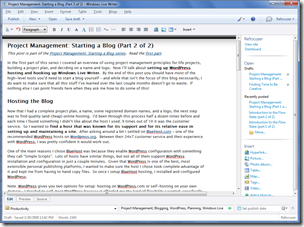Archive for the ‘Productivity’ Category
Bouncing at Zero – “ZBB” in Life
 In software development at Microsoft we have a concept that I’ve always found personally relevant. It’s called Zero Bug Bounce (ZBB) and it refers to a period in time in which the development team is consistently “bouncing at zero bugs” every single day. At this point in the project, all active bugs in the software have been looked at and either punted or fixed – and the team’s fix rate (or the rate at which they’re able to fix bugs) is greater than the team’s incoming rate (or the rate at which new bugs are being opened). The code is almost ready to see the light of day in the real world.
In software development at Microsoft we have a concept that I’ve always found personally relevant. It’s called Zero Bug Bounce (ZBB) and it refers to a period in time in which the development team is consistently “bouncing at zero bugs” every single day. At this point in the project, all active bugs in the software have been looked at and either punted or fixed – and the team’s fix rate (or the rate at which they’re able to fix bugs) is greater than the team’s incoming rate (or the rate at which new bugs are being opened). The code is almost ready to see the light of day in the real world.
I always love hitting and maintaining ZBB because there’s a complete sense of control over the project. Every member of the engineering team knows each and every bug and you can feel the momentum pulling you towards the eventual finish line. When that finish line means half a billion people are going to start downloading or using the thing you’ve been working on, it’s electric. Which is part of the reason I love my day job unlike most bloggers 😉
Several years ago I started thinking about a number of things in my life as being at ZBB in order to give myself a mental framework – and more importantly a visual – for getting to zero and bouncing off of it regularly. The list is actually quite extensive and includes my snail mail box, bills I need to pay, all of my various electronic inboxes, voicemails, RSS feeds, and so on. When these things aren’t under control I can immediately feel my blood pressure start to rise because it means I’m not being effective and important things could be slipping through the cracks and hitting the floor.
Keep the Plates Spinning
For those who haven’t heard the phrase “keep the plates spinning”, it refers to a circus trick involving about a dozen spinning plates on the end of poles (see photo to the right). The performer has to keep all the plates spinning because if any one of the plates slows down too much, it’s going to fall off the pole and smash into pieces on the floor. It’s fun to watch. The performer is constantly evaluating which plates are OK and which are trending towards disaster, and they’re making second-to-second judgments about how best to keep all the plates spinning together.
Sound familiar? Replace “performer” with your name and replace “plates” with responsibilities like work, family, or personal health. We’re just like those circus performers, running between our various responsibilities and commitments to keep them spinning just enough so they don’t fall off the sticks. Focus too long on one plate, no matter how important it seems, and you’ll find that the others will crash to the floor. Try and keep them all spinning at the same high velocity and you’ll almost certainly collapse out of exhaustion – it’s not sustainable.
While focus is about choosing a few things and doing them well, it’s rarely about choosing just one thing and doing that one thing well. That’s impossible to do – I can be a good father, but if I fail miserably to earn a paycheck, my daughter doesn’t eat. I can be great in the office, but if i don’t take care of myself physically and emotionally, I won’t have the energy to keep it up for very long (and while my daughter will eat, she wouldn’t know me from Stanley). We have to be multifaceted to some degree in our day-to-day approach.
So what do you do if you want to keep the plates spinning at various speeds consistently?
Project Management: Starting a Blog (Part 2 of 2)
This post is part of the Project Management: Starting a Blog series. Read the first part.
 In the first part of this series I covered an overview of using project management principles for life projects, building out a project plan, and deciding on a name and logo for your blog. Now I’ll talk about setting up WordPress hosting and hooking up Windows Live Writer. By the end of this post you should have most of the high-level tools you’d need to start a blog yourself – and while that isn’t the focus of this blog necessarily, I do want to make sure that all this stuff I’ve learned over the last couple months doesn’t go to waste. If nothing else I can point friends here when they ask me how to do some of this!
In the first part of this series I covered an overview of using project management principles for life projects, building out a project plan, and deciding on a name and logo for your blog. Now I’ll talk about setting up WordPress hosting and hooking up Windows Live Writer. By the end of this post you should have most of the high-level tools you’d need to start a blog yourself – and while that isn’t the focus of this blog necessarily, I do want to make sure that all this stuff I’ve learned over the last couple months doesn’t go to waste. If nothing else I can point friends here when they ask me how to do some of this!
Project Management: Starting a Blog (Part 1 of 2)
This post is part of the Project Management: Starting a Blog series. Read the second part.
 Project management is a lost art and much needed science outside of corporate America. Many people spend most of their working lives planning projects for a living, but leave that toolbox in the office when they jet for home. However, life is a series of projects – some of them so complex they would put to shame anything you’d encounter at work – and the same tactics that have been proven over the centuries to work for managing vast, interdependent projects like the Roman Aqueducts also work for cleaning out the basement on a Sunday afternoon.
Project management is a lost art and much needed science outside of corporate America. Many people spend most of their working lives planning projects for a living, but leave that toolbox in the office when they jet for home. However, life is a series of projects – some of them so complex they would put to shame anything you’d encounter at work – and the same tactics that have been proven over the centuries to work for managing vast, interdependent projects like the Roman Aqueducts also work for cleaning out the basement on a Sunday afternoon.
Project management doesn’t sound sexy though, does it? I’d bet you immediately imagined some geek with a clipboard, sitting in a cubicle, staring at a GANTT chart in Microsoft Project. But just work with me for a moment: what if the same process that works for that geek would work for you as well? Would it be worth a shot? What if learning some ”boring” project management skills helps you get that job you’ve always wanted, keeps you sane while moving across the country, or helps you to relax over your upcoming wedding?
Add little to little and there will be a big pile. Ovid 43 BCE – 17 CE
Over time I plan to cover project management in more detail and relate the strategies and tactics to focus and to life (an amorphous, ambiguous blob lacking structure). I strongly believe that solid project management skills can help you lose weight, get that degree you abandoned, start your own business, or… simply start a blog like I’m about to describe.
For now, let’s just examine how this blog got off the ground…
How to Read 200+ Blogs and Other Sites Everyday
(If you clicked on “what is this?” from the sidebar, you’ve come to the right place! This post will tell you all about how feeds and feed readers work. But if you’re just interested in getting email updates when Refocuser is updated, you can do that too!)
 The idea of reading over 200 blogs and other sites every single day sounds ridiculous, doesn’t it? In order to do this, you’d have to spend at least 60 seconds on each site assuming there haven’t been many updates, and if there’s anything new it could easily take 5-10 minutes each! Once you add this up you could end up spending more than 3 hours each day just scanning and reading stuff – which is the exact opposite of focus. For most people, this is just pure procrastination city!
The idea of reading over 200 blogs and other sites every single day sounds ridiculous, doesn’t it? In order to do this, you’d have to spend at least 60 seconds on each site assuming there haven’t been many updates, and if there’s anything new it could easily take 5-10 minutes each! Once you add this up you could end up spending more than 3 hours each day just scanning and reading stuff – which is the exact opposite of focus. For most people, this is just pure procrastination city!
There’s definitely a better way to do it, but it’s surprising how few people utilize it when you look at the stats. It’s called subscribing – so instead of you going out to all those sites and waiting for new information, the information comes to you in the form of a subscription.
Before I learned about RSS and Atom feeds, I was clicking around to dozens of sites multiple times per day like a crack addict in search of a hit. I would scan the entire page to see if anything had changed before moving on, and if something had changed I would spend a little extra time on that site. But in the 5 years since discovering feeds and feed readers, my routine is… well, it’s routine. I “read the paper” in the morning by scanning/reading through the overnight updates, I check-in during the afternoon to see what’s up, and then sometimes (but not always) I do another session in the early evening. Total time spent: 30-45 minutes maximum. And I subscribe to 227 different sites!
How to Read 3 or More Books a Month
 Many people I know are frustrated that they don’t have the time to read more. Between a commute, a time-consuming job, family responsibilities, and other hobbies, there just isn’t enough time in the day to start, much less finish, the book sitting on your nightstand. I’m certainly no exception – far too often I start a book with good intentions, just to have it collect dust next to my bed until I just give up and put it back on the shelf.
Many people I know are frustrated that they don’t have the time to read more. Between a commute, a time-consuming job, family responsibilities, and other hobbies, there just isn’t enough time in the day to start, much less finish, the book sitting on your nightstand. I’m certainly no exception – far too often I start a book with good intentions, just to have it collect dust next to my bed until I just give up and put it back on the shelf.
Sometimes it’s natural – not all books are worth finishing, and if you feel like you’ve already received 99% of the value in 10% of the time, sometimes it’s best to just move on. But oftentimes it takes a while for a book to get interesting, and giving up too soon means you’ll never know. Yet if you stick with it and don’t actually make the time to read, it could take 2-3 months to actually make it through – which means you may get to read just 3-4 books in a year.
There’s a better way. Note that some of these tips are clearly for people who a) want and love to read, and b) are frustrated with the amount of reading they can do. If you enjoy taking your time reading through a novel, ignore this post – but if learning and self-improvement are your goals, these tips can work wonders. Most of the books I read are non-fiction: self-help, fitness, productivity, business profiles, motivation, and so on. With books like these, I’m not looking for an experience, I’m looking for tools and tactics. And the more quickly I can synthesize and incorporate the information into my life the better!




